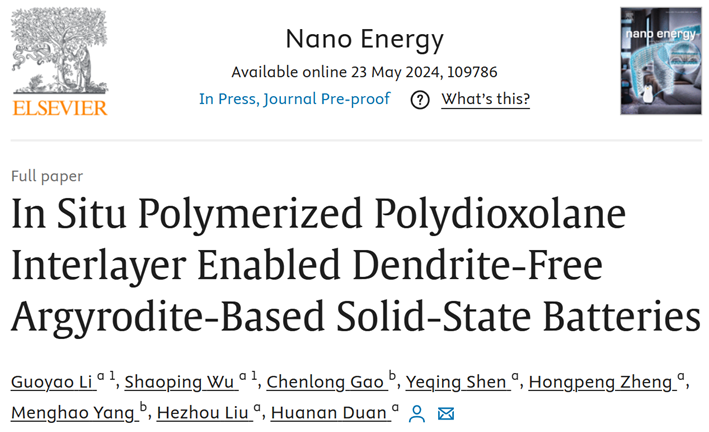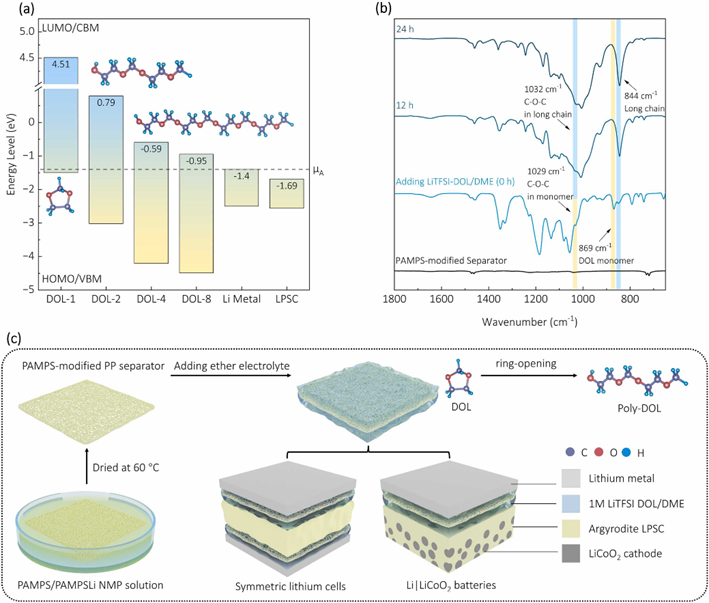Recently, a research group led by Professor Huanan Duan from the School of Materials Science and Engineering/National Key Laboratory of Metal Matrix Composites at Shanghai Jiao Tong University has published a significant paper in the renowned journal Nano Energy (2022 Impact Factor: 17.60). The paper, titled “In Situ Polymerized Polydioxolane Interlayer Enabled Dendrite-Free Argyrodite-Based Solid-State Batteries” features PhD students Guoyao Li and Shaoping Wu as co-first authors, with Professor Huanan Duan as the corresponding author.

Solid-state lithium batteries are seen as a promising solution to the trade-off between energy density and safety in traditional lithium-ion batteries, positioning them as a key direction for next-generation lithium batteries. Among various solid electrolytes, the argyrodite-type sulfide solid electrolyte (LPSC) stands out due to its exceptionally high ionic conductivity (>10 mS cm⁻¹) and its ability to be processed into solid-state battery devices through cold pressing. However, the stability of the LPSC/Li interface remains a critical challenge.
In this work, Li et al. introduced an in-situ polymerized ether-based interlayer between the LPSC and Li metal, significantly improving the stability of the LPSC/Li interface (Figure 1). The symmetric lithium cell achieved long-term stable cycling for 1250 hours at room temperature and a current density of 0.5 mA cm⁻²(Figure 2). The solid-state lithium battery modified with this polymer interlayer demonstrated an initial discharge capacity of 120.7 mAh g⁻¹ and a capacity retention rate of up to 95.4% after 200 cycles (Figure 3). Additionally, the group thoroughly analyzed the solid electrolyte interphase (SEI) layer on the lithium metal surface, elucidating the enhancement mechanism by first-principles calculations (in collaboration with Professor Menghao Yang from Tongji University) and X-ray photoelectron spectroscopy (XPS) in-depth analysis (Figure 4). This work follows the group's previous research on improving LPSC stability through Sn-O dual-substitution (Advanced Functional Materials 33 (2023) 2211805) and represents a breakthrough in the LPSC/Li interface study, significantly improving its stability and current density, and taking an important step forward in the application of solid-state lithium batteries.

Figure 1. (a) Calculation of LUMO/HOMO energy levels for ethers, lithium metal, and LPSC; (b) FT-IR spectra of the ether electrolyte before and after polymerization; (c) Schematic of the in-situ polymerized ether-based interlayer applied in symmetric lithium cells and solid-state batteries.

Figure 2: (a-c) Critical current density (CCD) test of the symmetric lithium cells at room temperature; (d) Long-term cycling performance of the Li|PDOL|LPSC|PDOL|Li symmetric cell at 0.5 mA cm⁻².

Figure 3: (a) Long-term galvanostatic cycling test of the solid-state lithium batteries at 60℃; (d) Voltage profiles of the solid-state lithium batteries at specific cycle numbers (1, 2, 3, 10, 50, and 100).

Figure 4: (a-d) XPS depth profiling of the C 1s, O 1s, F 1s, and S 2p spectra at the Li/DOL interface; (e-h) XPS depth profiling of the C 1s, O 1s, F 1s, and S 2p spectra at the Li/PDOL interface; (i-j) Schematic of the SEI layer on lithium metal.
Since 2013, Professor Huanan Duan's group has been dedicated to the synthesis, performance, and application research of lithium-ion solid electrolytes. The group has published a series of academic papers in Advanced Functional Materials, Nano Energy, Energy Storage Materials, Chemical Engineering Journal, Journal of Power Sources, and ACS Applied Materials & Interfaces.
This research was supported by the SJTU Global Strategic Partnership Fund (2021 SJTU-CORNELL) and the National Natural Science Foundation of China (51972211).
Paper Link:
https://doi.org/10.1016/j.nanoen.2024.109786
[Authors]:Guoyao Li,Huanan Duan
